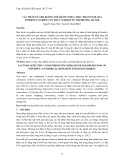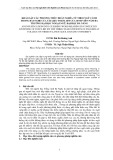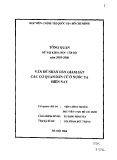
BioMed Central
Page 1 of 16
(page number not for citation purposes)
Implementation Science
Open Access
Study protocol
A randomized controlled trial of interventions to enhance
patient-physician partnership, patient adherence and high blood
pressure control among ethnic minorities and poor persons: study
protocol NCT00123045
Lisa A Cooper*1,2,3,4, Debra L Roter5, Lee R Bone5, Susan M Larson5,
Edgar R Miller III1,2,3, Michael S Barr6, Kathryn A Carson3 and
David M Levine2,5
Address: 1Welch Center for Prevention, Epidemiology and Clinical Research, Johns Hopkins University, Baltimore, Maryland, USA, 2Department
of Medicine, Johns Hopkins University School of Medicine, Baltimore, Maryland, USA, 3Department of Epidemiology, Johns Hopkins Bloomberg
School of Public Health, Baltimore, Maryland, USA, 4Department of Health Policy and Management, Johns Hopkins Bloomberg School of Public
Health, Baltimore, Maryland, USA, 5Department of Health, Behavior and Society, Johns Hopkins Bloomberg School of Public Health, Baltimore,
Maryland, USA and 6American College of Physicians, Practice Advocacy and Improvement Division, Washington, DC, USA
Email: Lisa A Cooper* - lisa.cooper@jhmi.edu; Debra L Roter - droter@jhsph.edu; Lee R Bone - lbone@jhsph.edu;
Susan M Larson - slarson@jhsph.edu; Edgar R Miller - ermiller@jhmi.edu; Michael S Barr - mbarr@mail.acponline.org;
Kathryn A Carson - karson@jhmi.edu; David M Levine - dlevine@jhmi.edu
* Corresponding author
Abstract
Background: Disparities in health and healthcare are extensively documented across clinical
conditions, settings, and dimensions of healthcare quality. In particular, studies show that ethnic
minorities and persons with low socioeconomic status receive poorer quality of interpersonal or
patient-centered care than whites and persons with higher socioeconomic status. Strong evidence
links patient-centered care to improvements in patient adherence and health outcomes; therefore,
interventions that enhance this dimension of care are promising strategies to improve adherence
and overcome disparities in outcomes for ethnic minorities and poor persons.
Objective: This paper describes the design of the Patient-Physician Partnership (Triple P) Study.
The goal of the study is to compare the relative effectiveness of the patient and physician intensive
interventions, separately, and in combination with one another, with the effectiveness of minimal
interventions. The main hypothesis is that patients in the intensive intervention groups will have
better adherence to appointments, medication, and lifestyle recommendations at three and twelve
months than patients in minimal intervention groups. The study also examines other process and
outcome measures, including patient-physician communication behaviors, patient ratings of care,
health service utilization, and blood pressure control.
Methods: A total of 50 primary care physicians and 279 of their ethnic minority or poor patients
with hypertension were recruited into a randomized controlled trial with a two by two factorial
design. The study used a patient-centered, culturally tailored, education and activation intervention
for patients with active follow-up delivered by a community health worker in the clinic. It also
included a computerized, self-study communication skills training program for physicians, delivered
Published: 19 February 2009
Implementation Science 2009, 4:7 doi:10.1186/1748-5908-4-7
Received: 14 November 2008
Accepted: 19 February 2009
This article is available from: http://www.implementationscience.com/content/4/1/7
© 2009 Cooper et al; licensee BioMed Central Ltd.
This is an Open Access article distributed under the terms of the Creative Commons Attribution License (http://creativecommons.org/licenses/by/2.0),
which permits unrestricted use, distribution, and reproduction in any medium, provided the original work is properly cited.






























